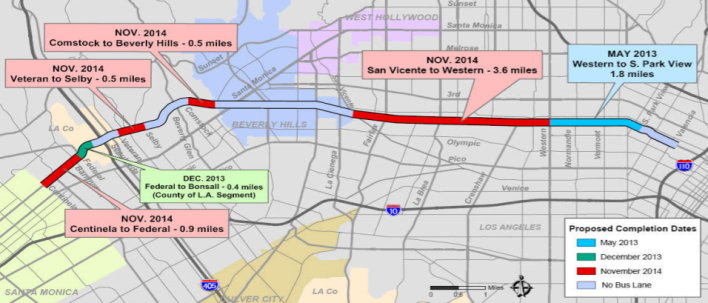
Elected officials and agency representatives gathered yesterday to host a ribbon-cutting event for Wilshire Boulevard's newest peak-hour bus-only lanes. The $31.5 million project, dubbed the Wilshire Bus Rapid Transit (BRT) is a joint effort of Metro, L.A. City, and L.A. County. The bus-only lanes operate from 7-9 a.m. and 4-7 p.m.
The celebration took place at the La Brea Tar Pits. Speakers included L.A. Mayor and Metro Board Chair Eric Garcetti, Federal Transit Administration Team Leader Ray Tellis, County Supervisor Mark Ridley-Thomas, Metro Boardmember Jackie Dupont-Walker, Metro's Interim Deputy CEO Stephanie Wiggins, L.A. City Councilmembers Mike Bonin, Tom LaBonge, and Paul Koretz, and others. The event was attended by about 120 people, mostly governmental staff.
Streetsblog readers will remember the struggle to get this project underway. Due to politics, the bus lane facility ended up somewhat on-again off-again. Though most of Wilshire Blvd within the city of Los Angeles is included, the bus-only lane does not include Westwood's "Condo Canyon" stretch, nor the parts of Wilshire inside the cities of Beverly Hills and Santa Monica.

An initial 1.8 miles of the Wilshire BRT already opened in June 2013. That section goes from MacArthur Park to Western Avenue.
As of today, four new segments are live, totaling five new miles:
- Western Avenue to San Vicente Boulevard (3.6 miles)
- Beverly Hills to Comstock Avenue (0.5 miles)
- Selby Avenue to Veteran Avenue (o.5 miles)
- Bonsall Avenue to Federal Avenue (0.4 miles)
The final 0.9 mile segment, from Federal Avenue to Centinela Avenue, is expected to open in fall, 2015.
Some speakers at the ribbon-cutting sounded less interested in the completed multi-million dollar BRT than in the future multi-billion dollar Purple Line subway extension which will run in the same corridor. The first of three subway extensions phases recently broke ground and is expected to reach La Cienega Boulevard in 2023.
Both Garcetti and Bonin emphasized Wilshire BRT's immediate benefit to huge numbers of people already riding buses here. According to Metro, there are 55,000 daily boardings and 50 percent of these take place during peak hours. Bonin and Garcetti expressed their interest in extending forms of BRT to other Los Angeles transportation corridors. At Garcetti's and other boardmembers' urging, Metro is currently studying BRT improvements for Vermont Avenue and for a connection between the San Fernando Valley and the San Gabriel Valley.
Councilmember Koretz elicited the biggest laugh of the day, when he encouraged Wilshire Boulevard's fast-moving bus riders not to make obscene gestures to drivers stuck in traffic in other lanes.
Curb-lane BRT often experiences delays due to conflicts with drivers using the curb lane illegally. New York City and San Francisco have had some success discouraging illegal driver activity by equipping buses with enforcement cameras, able to ticket drivers parked or cruising in bus-only lanes. A proposed state bill, A.B. 1287, would make S.F.'s bus camera program permanent.
Bus riders - how are L.A. drivers treating our bus-only lanes? Is more enforcement needed? by LAPD? or should Metro try on-board enforcement cameras? What other ideas do readers have to make L.A. rapid transit as rapid as possible? Let us know in the comments below






